PPT-RESPIRATORY SYTEM Anatomy & Physiology
Author : deena | Published Date : 2024-03-13
BACKGROUNDCellular Respiration Oxygen is used by cells Oxygen is needed to convert glucose to ATP Carbon dioxide is a waste product Body cells die if respiration
Presentation Embed Code
Download Presentation
Download Presentation The PPT/PDF document "RESPIRATORY SYTEM Anatomy & Physiol..." is the property of its rightful owner. Permission is granted to download and print the materials on this website for personal, non-commercial use only, and to display it on your personal computer provided you do not modify the materials and that you retain all copyright notices contained in the materials. By downloading content from our website, you accept the terms of this agreement.
RESPIRATORY SYTEM Anatomy & Physiology: Transcript
Download Rules Of Document
"RESPIRATORY SYTEM Anatomy & Physiology"The content belongs to its owner. You may download and print it for personal use, without modification, and keep all copyright notices. By downloading, you agree to these terms.
Related Documents














